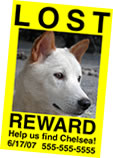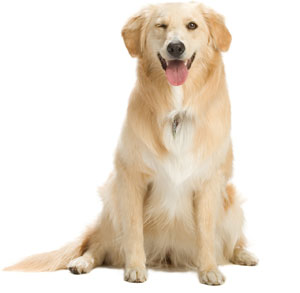The statistics are troubling: One in three pets will get lost. Without identification, only 10% will return home. Losing your beloved dog or cat is a terrible experience, and we hope it never happens to you. Follow the links below for specific advice:
 The Best Option: Prevent Your Pet From Getting Lost
The Best Option: Prevent Your Pet From Getting Lost
What To Do If You’ve Lost Your Pet
What To Do If You’ve Found A Pet
THE BEST OPTION:
PREVENT YOUR PET FROM GETTING LOST IN THE FIRST PLACE:
Don’t have an “it can’t happen to me” attitude:
Don’t ever assume just because your dog or cat has never gotten out before that it can’t happen. Nobody ever thinks their pet will get lost; if they did, they’d know how to prevent it from happening. Think about these possibilities: What if there’s a fire while you’re at work and firemen kick the door open? What if an earthquake shatters windows? What if a sudden thunderstorm or fireworks causes your dog to get scared and dig under a fence or jump through a window? Perhaps a local utility worker opens your gate. The point is, there are a million reasons why an environment you think is secure can be compromised through no fault of your own. Know that it can happen to you, and be prepared.
Proper identification is your pet’s best chance of being returned:
- First and foremost: keep identification on your pet. When your dog or cat gets out, he can’t go up to a stranger and tell them his name and address. ALWAYS keep tags on your dog or cat with a current phone number (with area code). The moment your phone number changes, get new tags!
 We cannot stress this enough…get your pet MICROCHIPPED. If you adopt an already-microchipped pet, send in the paperwork and get the chip registered in your name. In case your pet’s ID tag falls off, this is your one chance to make sure your pet will be returned to you. If you move or change your phone number, make sure to contact the microchip company right away to notify them of your new information.
We cannot stress this enough…get your pet MICROCHIPPED. If you adopt an already-microchipped pet, send in the paperwork and get the chip registered in your name. In case your pet’s ID tag falls off, this is your one chance to make sure your pet will be returned to you. If you move or change your phone number, make sure to contact the microchip company right away to notify them of your new information.- When traveling with your pet, add a temporary tag with local contact information, if possible.
Other precautionary measures:
- Keep good, recent photos of your pets. These will come in handy if your pet gets lost and you need to distribute flyers.
- If your dog spends any time alone in your yard, check your fence and gates often for signs of wear. Check along the bottom of the fence for signs your dog is digging.
- Be especially careful on holidays like the Fourth of July and New Years Eve, when fireworks cause more pets to bolt than any other days of the year. The shelters are absolutely filled with pets on July 5th and January 1st—make sure your pet is not among them. Keep in mind that extreme fear can cause your pet to behave out of character. Many pets become frightened and panicked enough to jump through windows or bust right through fences.
IF YOU’VE LOST YOUR DOG OR CAT:
This is obvious, but it bears saying anyway. If your pet is lost, there are only a few possibilities: Your pet is either on the streets, your pet has been found and taken somewhere like a shelter, someone’s home, or to a rescue organization, or your pet has been stolen. The following suggestions deal with each of these possibilities to ensure your pet has the best chance of coming home again.
In case your pet is still on the street:
- If you have a regular route where you walk your dog, comb that route on foot. Bring along a leash, strong-smelling food, such as a hamburger patty, hot dog, or an open can of wet cat food, and your dog’s favorite noise-making toy. Keep in mind that your dog may be hiding out of view, especially if he or she is afraid, so walk slowly and alternate between calling your dog’s name and listening quietly for any movement or response.
- If you’ve lost your cat, he or she may not have roamed very far. Try leaving some food out at night, when cats are most active, and note if the food is being eaten. If you’re not sure if it’s your cat or a wild animal eating the food, here’s a tip: place the food on a mat, and sprinkle baby powder on the mat. In the morning, you’ll be able to see paw prints in the powder, which will let you know the size of the animal that’s been chowing down!
Flyers are a must. Here are some tips for effective flyers:
- Flyers should always include a photo, ideally a close-up photo made as large on the page as possible.
- Keep in mind that most people who see your flyers will be driving by quickly or will see your flyer from a distance, so make them as easy-to-read and as eye-catching as possible. Make the flyer with brightly-colored paper. Use the largest photo and letters possible.

- Keep the information very simple. Include the word “Lost”, a large photo, the pet’s name, the date, your phone number, and the word “reward”, if one is being offered (see below). Do not give out too much information. You will want to make sure anyone who calls you is actually in possession of your dog or cat, especially if you’re offering a reward, and you can do that by asking them for more specific information, like color of the collar your dog was wearing or the location of your cat’s three brown spots.
- Always include the date so people know it’s a current flyer will actively be on the lookout.
- Consider offering a reward. The word “Reward” on a flyer is very eye-catching and may cause more people to look at your pet’s information and photo. A reward is also a good incentive for people to be extra vigilant in keeping an eye out for your pet. Be sure you have your pet back in your possession before you give out the reward—there are unscrupulous people out there willing to scam a heartbroken pet owner out of reward money, so be careful.
- Place flyers not just on telephone poles and signposts, but also on car windshields in your neighborhood, on local public bulletin boards in retail stores and parks, and in the lobby of apartment buildings nearby. If the apartment lobby is locked, don’t be shy about asking a resident to let you in so you can post a notice.
- Hang your flyers in a wider area than you’d think necessary. Dogs and cats can end up quite far away in a short period of time.
- Bring flyers to all local veterinary offices. If someone has found your pet, there’s a chance they’ll take him or her to a vet to be checked out and scanned for a microchip.
Be Proactive in Your Search:
- Immediately call and visit all local animal shelters, even those you think might be farther away than you think your pet would have traveled. A phone call to the shelter is a first step, but should always be followed up by a visit; sometimes the volume of animals in the shelter is so high that the staff may not be aware of new pets that have been brought in. Call and visit the shelters very frequently, daily if possible, keeping in mind that in shelters that euthanize, your window of opportunity to claim your pet may be limited
- At the shelter, make sure you check in all areas, including the infirmary. Also, a more unpleasant task that we hate to mention: check the shelter’s list of dogs that have been impounded deceased.
- Call and email all the animal rescue groups in your area. Often, the first thing a well-meaning person who found a dog or cat will do is call no-kill rescue groups to see if they can take the pet. Ask your local rescue groups if they’ve taken in a pet matching your dog or cat’s description or if they’ve been contacted by someone who found such a pet.
- Keep actively searching and visiting your shelter for at least two to three months.
- Place a Lost Pet ad in your local paper’s classified section. Check all local classifieds for a Found Pet ad, too.
- There are many web sites that specialize in lost and found pet postings. Be sure to check these out and utilize their service as well.
- Post flyers, much in the same way as a person who lost their pet would. See the section above for detailed advice.
- Keep a couple of key details off the flyer. Give out only enough information so the pet’s owner will suspect it’s their pet. For instance, if you find a Bichon Frise with a red collar, you might advertise “Found: Small white dog with collar”. When the owner calls, ask him or her to describe the collar and ask what breed their dog is. Beware of unscrupulous characters who will try to claim dogs for nefarious purposes.
- If you can safely house the pet while you attempt to find the owner, that’s wonderful. If not, call local rescue groups to see if anyone has room to foster the pet for you and to help find the pet a new home if the owner cannot be located.
- Take the dog or cat to a vet or shelter to have him scanned for a microchip.
- If there are children playing in the neighborhood where you found the pet, talk to them! Children are an incredibly valuable resource in this situation—they tend to know all the pets in the neighborhood by sight, since they spend so much time outdoors.
- Call all local shelters to see if anyone has reported their dog missing. Post flyers in all shelters.
- Take flyers to all veterinary offices in the area. If they don’t recognize the pet as one of their patients, ask if they can post the flyer in the waiting room.
- Place a Found Pet ad in your local newspaper classifieds, and check for a Lost Pet ad as well.
- There are many web sites that specialize in lost and found pet postings. Be sure to check these out and utilize their service as well.
 3. How often does my pet need a checkup?
3. How often does my pet need a checkup? Like this article? Feel free to post it on your site!
Like this article? Feel free to post it on your site!




